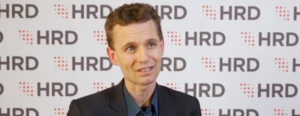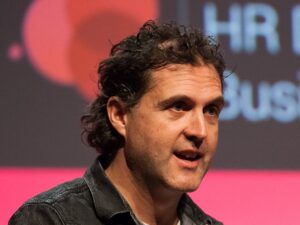Mindfulness at Work: Training your mind to manage attention
- 7 Min Read
In an always-on, multi-tasking environment, attention is under siege and effectiveness suffers. Maintaining resilience in the face of constant change and uncertainty, sustaining presence, balancing priorities and being stretched too thin are key challenges for us all. This September, the Estee Lauder London HQ welcomed Louise Chester, Founder and Managing Director of corporate advisors ‘Mindfulness […]
- Author: Unzela Khan
- Date published: Oct 12, 2017
- Categories

In an always-on, multi-tasking environment, attention is under siege and effectiveness suffers. Maintaining resilience in the face of constant change and uncertainty, sustaining presence, balancing priorities and being stretched too thin are key challenges for us all.
This September, the Estee Lauder London HQ welcomed Louise Chester, Founder and Managing Director of corporate advisors ‘Mindfulness at Work’, to discuss this topic further with a group of senior HR leaders.
The company, which was founded eight years ago, enables people and businesses to truly flourish. For their client organisations, Mindfulness at Work curates best-in-class mind training programmes for the workplace – helping design and deploy organisational initiatives that have already enabled well over 100,000 employees find the workplace a more productive, creative, fulfilling and enjoyable place to be.
This practical session showcased Potential Project ‘Corporate-Based Mindfulness Training’ (CBMT) and introduced participants to the science of mindfulness, as well as providing mental strategies and mind training to sharpen focus, enhance clarity and build mental effectiveness for more sustainable performance and greater well-being.
What is Mindfulness?
Louise explained that mindfulness can be thought of as the ability to have focus and discernment, to choose where you place your attention and be aware you have the option to make wiser choices in every moment. In our busy lives we often default to an auto-pilot reaction rather than a conscious response. Mindfulness helps us stay one second ahead of our reactivity, locate that space between stimulus and response, and choose the value-creating behaviour that that helps us and others truly flourish.
The programmes that Mindfulness at Work recommends all have mind training as their foundation, but are tailored to an organisations particular business imperatives and can include Work Techniques, which includes ways to communicate, meet, innovate and embrace change more effectively, and Mental Strategies such as patience, kindness and acceptance which help us to meet life with more resilience..
How attentive are you?
Louise said: Since our inception in 2o10, we have worked with over 200 organisations in the UK alone and their description of working life has led our partners at Potential Project to name this the PAID Reality – Pressured, Always on, Information overloaded and Distracted.
This leads to what scientist now term Attention Deficit Trait. Research has shown that, on average, we are distracted 46.9% of the time – often more so at work. And this ADT manifests as us being inefficient, change resistant, cognitively rigid, overwhelmed, stressed and disengaged.
However, we are able to train our minds to become the master of our attention once more. A case study of Potential Project CBMT training at Accenture resulted in a 30% rise in focus, 17% decrease in distractedness and a 25% decrease in unproductive multitasking, with 100% of participants recommending the programme to colleagues
“With just 10 minutes of mind training per day, changes to both the structure and function of the brain can be experienced.”
Basic mindfulness training
The Potential Project CBMT programme helps people with the foundational skill of managing attention of the task at hand.
Basic training focuses on four stages:
- Anatomy – Adopt a stable, dignified sitting position with straight spine, feet flat on the floor, and hands resting in the lap or on the knees. Become aware of how this feels, getting fully present with yourself.
- Breath – Choosing the breath as the anchor for your attention and observe the physical sensation of breathing, perhaps focussing on one particular area, such as the slight movement in the abdomen
- Counting – In the early stages of developing a practice, add the additional anchor of counting each outbreath to help you keep on track. Breathe in and out, count one, breathe in and out, count two. Do this up to 10 and back down to 1. Then continue to count in cycles like this.
- Distractions: There will be many! Your mind will wander involuntarily from the anchor of breath and counting. Celebrate the moment that you are aware that your mind has been hijacked by a distracting thought, sound, emotion. This moment of awareness IS the mindful moment. Now you are inhabiting the space between stimulus and response and can gently bring your attention back to the object of attention you chose – in this case, your breathing and counting,
Louise advised us that kindness to ourselves is a very under-rated performance tool. A huge body of research points to this as a corner-stone for building resilience. So, notice our desire to do everything perfectly and the harsh internal critical voice that might kick in when we notice how distracted we are. She suggested bringing some warm curiosity to this awareness and seeking to replace this voice with a kinder one throughout our practice.
Multi-tasking is a myth. Although we may think we are efficient multi-taskers, our brains are not computers and our minds can only able to focus effectively on one thing at a time. In fact, when ‘multi-tasking’ our mind is actually switching between tasks – making multi-tasking is a myth. This ‘task-switching’ reduces our efficiency, kills prioritisation due to our loss of overview, decreases quality of work, hampers creativity, drains energy, feels stressful and eventually reduces our well-being.
Louise shared research from University College London showing that the brains of fervent multi-taskers have reduced grey matter in the area of the brain attributed to overview or awareness (the anterior cingulate cortex), where functions such as error detection, anticipation of tasks, attention, motivation and the modulation of emotional responses take place. In the words of McKinsey Quarterly ‘Multitasking is a terrible coping mechanism. Scientific evidence demonstrates that multitasking makes us less productive, less creative, and less able to make good decisions. If we want to be effective, we need to stop.
But how, in the PAID reality can we stop? Louise shared Potential Project’s Two Rules of Mental Effectiveness
- Focus on what you choose: only on that one task, noticing distractions (office chat or Inbox notifications) and choosing to bring your attention back to the task in hand, again and again.
- Choose your distractions mindfully: having the awareness to choose to release what you were paying attention to and give your distraction your full attention. For example, you are working and someone comes over to your desk with something vital they need your help with. If appropriate, you can choose to release your attention from your task and give that person your full attention. What you don’t do is try to simultaneously pay attention to your task AND your colleague – this ‘multi-tasking’ means you do both things inefficiently
These practical applications, along with the great techniques around prioritisation, presence and mindful communication that were shared in the workshop, enabled the assembled HR Directors to see how training our mind and applying these simple skills can enable so many positive benefits both for individuals and the organisations where they work.
______________________________________________________________
Louise Chester first started practising mindfulness in 1994. It helped her retain equanimity and balance, while sustaining a pressured senior career in investment banking and fund management.
In 2010, she established Mindfulness at Work, to support organisations with highly-effective mindfulness training; enabling their teams to have greater focus and clarity, deliver greater value, and thrive not just at work, but in all areas of their life.
As trusted advisor, Mindfulness at Work offers best-in-class programmes, both online and face-to-face, to over 200 organisations in every region of the world. Having introduced over 100,000 to mindfulness in the UK and many thousands more through the global Potential Project network, Louise and her team are uniquely placed to advise on how to enable organisational excellence through evidence-based mindfulness training.
Louise has also contributed to two forthcoming books, Potential Project’s ‘The Mind of the Leader’ and ‘Conscious Capitalism – the Workbook’. Both to be published by Harvard Business Press early in 2018.



